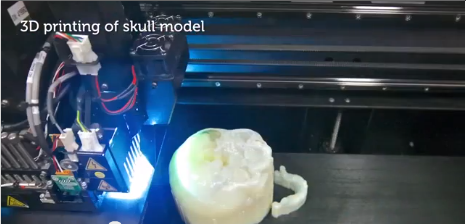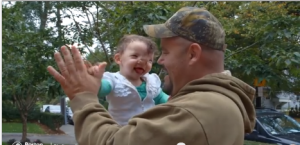Prior to her birth, Violet’s parents learned that she had a rare craniofacial anomaly called frontal nasal dysplasia. When these parents-to-be, Alicia and Matt, turned to their doctors for guidance, no one had had any experience with this particular condition. As any parent can imagine, that didn’t stop them from looking for the answers they needed. Their search led them to the Boston Children’s Hospital. There they found Dr. John Meara, who had dealt with a number of these cases and quickly reassured the parents that their daughter would be in good hands.
The surgery required to address her condition is nothing to be taken lightly. The bone in her skull has to be cut and reshaped in order to bring her eyes closer together and to lessen the distance between the two sides of her nose. As such, in addition to Dr. Meara’s experience as a cranial and cleft surgeon, a neurosurgeon, Dr. Mark Proctor, joined the team of professionals to be involved in her operation.

Children change incredibly quickly, and even more so when they are infants and toddlers. As such, the shape of Violet’s skull has changed even since her initial examination. Luckily, the team at Boston Children’s Hospital has embraced the possibilities offered through 3D printing technology. They created a model and print of Violet’s skull when she arrived and created another just prior to her surgery. Through comparing these two prints they were able to track the changes in the bony dimensions and growth of the skull. Dr. Weinstock, Director of Boston Children’s Hospital Simulator Program, explained the way 3D printing has become integrated in the preparation and performance of surgery:
“Three dimensional printing has been, in many ways, sort of a natural extension of what we’ve done in simulation from our very beginning. It allows us now to produce exact reproductions of a child’s anatomy that allow the surgeons at Children’s, within the settings of simulation to do the surgery, before the surgery.”
Dr. Weinstock called Drs. Meara and Proctor “early, early-adopters” who had been able to instinctually understand the value of the technology and were able to easily integrate into their practice. Rather than having to wait to get to the operating room in order to physically interact with the anatomy they were to address, the doctors can now become familiar with it through hands on interface. It’s not simply early access that’s helpful. It’s the time that is available to study the print and the ability to look and explore the terrain without obstructions and without worry of damage.
Violet’s story is shared through a four-part video series on the Children’s Hospital website. It begins with an introduction to the family, continues with an explanation of the team of specialists and techniques that are used to address the surgery, and two parts to be released that detail the little girl’s surgery and recovery. It’s a compelling story and a wonderful reminder of the enormous benefits to medicine that have been brought through 3D printing. The journey is fraught with difficulty and it is hard not to tear up as the parents discuss their love and hope for their daughter.
“There’s a lot of moments as parents that you don’t think you’ll ever forget. And then they kind of fade into the everyday grind. And then there are those certain things that stand out. We had a moment last night, she woke up in the middle of the night, she reached her arms out and gave me a couple of great big kisses… It was like she was telling us it was going to be all right.”
This isn’t the first time we’ve seen this kind of modeling be part of surgical preparation but we live in a time when it is still new enough to be a marvelous reminder of the potential benefits of this technology as yet to be imagined.
Below is a video from Boston Children’s Hospital, where we can meet the team behind Violet’s model and surgery. What do you think of Violet’s amazing story and the implications 3D modeling has on such surgeries for countless children like her? Let us know your reaction over in the Violet’s Journey 3D Model for Toddler’s Surgery forum thread at 3DPB.com.
Subscribe to Our Email Newsletter
Stay up-to-date on all the latest news from the 3D printing industry and receive information and offers from third party vendors.
Print Services
Upload your 3D Models and get them printed quickly and efficiently.
You May Also Like
3D Printing News Briefs, July 2, 2025: Copper Alloys, Defense Manufacturing, & More
We’re starting off with metals in today’s 3D Printing News Briefs, as Farsoon has unveiled a large-scale AM solution for copper alloys, and Meltio used its wire-laser metal solution to...
Etsy Design Rule Change Reduces Selection of 3D Printed Goods
Online marketplace Etsy has implemented a rule change requiring all 3D printed goods on the site to be original designs. The update to the site’s Creativity Standards states, ¨Items produced using...
Siraya Tech Introduces New Elastomer 3D Printing Materials, Including Foaming TPU
California company Siraya Tech, founded in 2019 with a focus on material science, customer focus, and agility, develops high-quality 3D printing materials that meet the needs of creators, hobbyists, and...
3D Printing News Briefs, April 12, 2025: RAPID Roundup
The news from last week’s RAPID+TCT in Detroit just keeps on coming! That’s why today’s 3D Printing News Briefs is another RAPID Roundup of more exciting announcements from the trade...



































